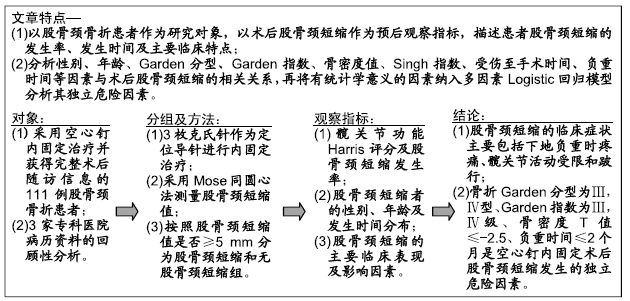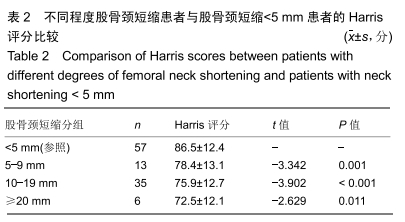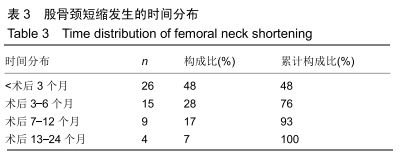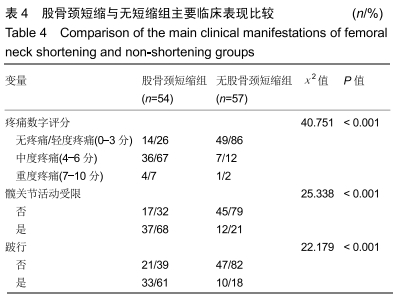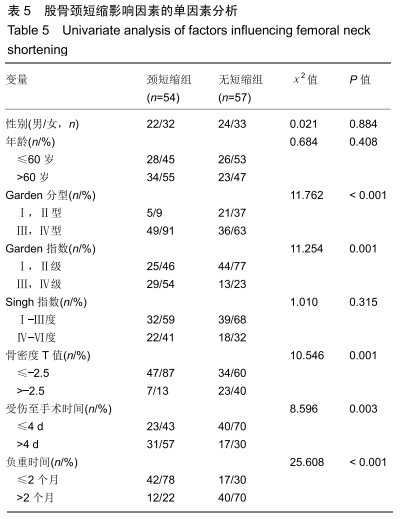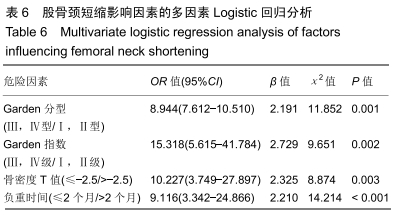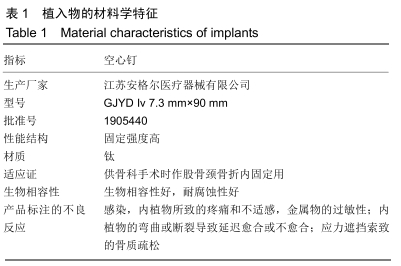[1] WANG XD, LAN H, LI KN. Treatment of femoral neck fractures with cannulated screw invasive internal fixation assisted by orthopaedic surgery robot positioning system. Orthop Surg. 2019; 11(5): 864-872.
[2] PRITCHETT J. Large diameter total hip replacement for acute displaced femoral neck fracture. J Long Term Eff Med Implants. 2019;29(1):71-78.
[3] MURPHY DK, RANDELL T, BRENNAN KL, et al. Treatment and displacement affect the reoperation rate for femoral neck fracture. Clin Orthop Relat Res. 2013;471(8): 2691-2702.
[4] 曹发奇,周武,刘国辉,等.股骨颈骨折复位内固定术后股骨头坏死的相关因素分析[J].中华骨科杂志,2017,37(17):1088-1092.
[5] 董忠,章镇南,吴斌.福州地区老年骨折患者回顾性分析[J].中国骨质疏松杂志,2018,24(7):949-953.
[6] 孙宣,鲍自立,傅强,等.苏中地区3所中医院老年股骨颈与股骨粗隆间骨折的流行病学分析[J].中国骨与关节损伤杂志,2018,33(2): 161-162.
[7] SAXER F, STUDER P, JAKOB M, et al. Minimally invasive anterior muscle-sparing versus a transgluteal approach for hemiarthroplasty in femoral neck fractures-a prospective randomised controlled trial including 190 elderly patients. BMC Geriatr. 2018; 18(1): 222.
[8] VAN DER SIJP MPL, SCHIPPER IB, KEIZER SB, et al. Prospective comparison of the anterior and lateral approach in hemiarthroplasty for hip fractures: a study protocol . BMC Musculoskelet Disord. 2017; 18(1): 361.
[9] FELTON J, SLOBOGEAN GP, JACKSON SS, et al. Femoral neck shortening after hip fracture fixation is associated with inferior hip function: Results From the FAITH Trial. J Orthop Trauma. 2019; 33(10):487-496.
[10] WANG CT, CHEN JW, WU K, et al. Suboptimal outcomes after closed reduction and internal fixation of displaced femoral neck fractures in middle-aged patients: is internal fixation adequate in this age group? BMC Musculoskelet Disord. 2018; 19(1): 190.
[11] HAIDER T, SCHNABEL J, HOCHPÖCHLER J, et al. Femoral shortening does not impair functional outcome after internal fixation of femoral neck fractures in non-geriatric patients . Arch Orthop Trauma Surg. 2018;138(11): 1511-1517.
[12] DONG Q, HAN Z, ZHANG YG, et al. Comparison of transverse cancellous lag screw and ordinary cannulated screw fixations in treatment of vertical femoral neck fractures. Orthop Surg. 2019; 11(4): 595-603.
[13] BORAIAH S, PAUL O, HAMMOUD S, et al. Predictable healing of femoral neck fractures treated with intraoperative compression and length-stable implants. J Trauma. 2010;69(1): 142-147.
[14] 梁金龙,陆声.髋关节旋转中心测量方法的研究进展[J].中国矫形外科杂志,2014,22(6):512-515.
[15] ZLOWODZKI M, JONSSON A, PAULKE R, et al. Shortening after femoral neck fracture fixation: is there a solution? Clin Orthop Relat Res. 2007; 461: 213-218.
[16] BORAIAH S, PAUL O, HAMMOUD S, et al. Predictable healing of femoral neck fractures treated with intraoperative compression and length-stable implants. J Trauma. 2010;69(1): 142-147.
[17] WANG G, TANG Y, WANG B, et al. Minimally invasive open reduction combined with proximal femoral hollow locking plate in the treatment of Pauwels type III femoral neck fracture . J Int Med Res. 2019; 47(7): 3050-3060.
[18] CRONIN PK, FRECCERO DM, KAIN MS, et al. Garden 1 and 2 femoral neck fractures collapse more than expected after closed reduction and percutaneous pinning. J Orthop Trauma. 2019; 33(3): 116-119.
[19] ROGMARK C, KRISTENSEN MT, VIBERG B, et al. Hip fractures in the non-elderly-Who, why and whither? Injury. 2018; 49(8): 1445-1450.
[20] BARTELS S, GJERTSEN JE, FRIHAGEN F, et al. Low bone density and high morbidity in patients between 55 and 70 years with displaced femoral neck fractures: a case-control study of 50 patients vs 150 normal controls. BMC Musculoskelet Disord. 2019; 20(1):371.
[21] WANG WT, LI YQ, GUO YM, et al. Risk factors for the development of avascular necrosis after femoral neck fractures in children: a review of 239 cases. Bone Joint J. 2019;101(9):1160-1167.
[22] VENKATADASS K, AVINASH M, RAJASEKARAN S. Bilateral avascular necrosis of the femoral head following asynchronous postictal femoral neck fractures: a case report and review of the literature . J Pediatr Orthop B. 2018;27(3):274-278.
[23] 姜达君,贾伟涛,张长青.青壮年股骨颈骨折复位技巧和内固定选择[J]. 中华创伤骨科杂志,2018,20(7):588-593.
[24] CHEN X, ZHANG J, WANG X, et al. Incidence of and factors influencing femoral neck shortening in elderly patients after fracture fixation with multiple cancellous screws. Med Sci Monit. 2017;26(23): 1456-1463.
[25] BARQUET A, GIANNOUDIS PV, GELINK A, et al. Femoral neck fractures after removal of hardware in healed trochanteric fractures. Injury. 2017;48(12):2619-2624.
[26] 夏希,刘智. 老年股骨颈骨折空心螺钉固定术后颈短缩的测量及其对髋关节功能的影响[J].中华创伤骨科杂志,2014,16(8):651-655.
[27] 王志生,吴志新.多方向空心钉内固定对股骨颈骨折术后颈短缩的控制[J].中国矫形外科杂志,2016,24(14):1253-1257.
[28] YE Y, CHEN K, TIAN K, et al. Medial buttress plate augmentation of cannulated screw fixation in vertically unstable femoral neck fractures: Surgical technique and preliminary results. Injury. 2017; 48(10): 2189-2193.
[29] WEIL YA, QAWASMI F, LIEBERGALL M, et al. Use of fully threaded cannulated screws decreases femoral neck shortening after fixation of femoral neck fractures. Arch Orthop Trauma Surg. 2018;138(5): 661-667.
[30] ZHANG B, LIU J, ZHU Y, et al. A new configuration of cannulated screw fixation in the treatment of vertical femoral neck fractures. Int Orthop.2018;42(8): 1949-1955.
[31] 冯晓飞,余霄,庞清江.股骨颈骨折内固定术后股骨颈短缩的临床特点[J].中华骨与关节外科杂志,2018,11(5):364-369.
[32] GUO J, DONG W, JIN L, et al. Treatment of basicervical femoral neck fractures with proximal femoral nail antirotation . J Int Med Res. 2019;47(9):4333-4343.
[33] NANTY L, CANOVAS F, RODRIGUEZ T, et al. Femoral neck shortening after internal fixation of Garden I fractures increases the risk of femoral head collapse. Orthop Traumatol Surg Res. 2019;105(5): 999-1004.
[34] GUO J, DONG W, YIN B, et al. Intramedullary nails with cannulated screw fixation for the treatment of unstable femoral neck fractures. J Int Med Res. 2019;47(2): 557-568.
[35] NANTY L, CANOVAS F, RODRIGUEZ T, et al. Femoral neck shortening after internal fixation of Garden I fractures increases the risk of femoral head collapse. Orthop Traumatol Surg Res. 2019;105(5): 999-1004.
[36] OKIKE K, UDOGWU UN, ISAAC M, et al. Not all garden-i and ii femoral neck fractures in the elderly should be fixed: effect of posterior tilt on rates of subsequent arthroplasty. J Bone Joint Surg Am. 2019;101(20):1852-1859.
[37] WEIL YA, KHOURY A, ZUAITER I, et al. Femoral neck shortening and yams collapse after navigated fixation of intracapsular femoral neck fractures. J Orthop Trauma. 2012;26(1):19-23.
[38] MIN BW, LEE KJ, BAE KC, et al. Result of internal fixation for stable femoral neck fractures in elderly patients. Hip Pelvis. 2016; 28(1): 43-48.
[39] SUNG YB, JUNG EY, KIM KI, et al. Risk factors for neck shortening in patients with valgus impacted femoral neck fractures treated with three parallel screws: is bone density an affecting factor? Hip Pelvis. 2017;29(4): 277-285.
|
